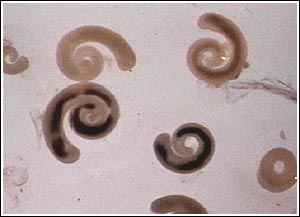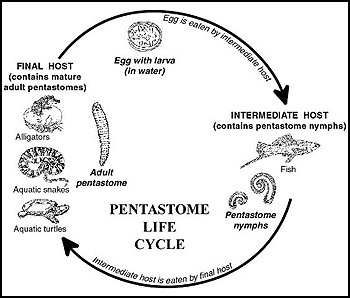

 |
||||||||||||
 |
||||||||||||
| Pentastomid Infections in Fish | ||||||
| Roy P. E. Yanong | ||||||
What Are Pentastomes? The pentastomes are a group of worm-like parasites that infect many different species of fish. Infections have been found in several families of fish including the Cichlidae (tilapia), Cyprinidae (danios), Cyprinodontidae (flagfish), and Poecilidae (mosquitofish, swordtails, mollies, platies). Although pentastomes are small, they can be seen without the use of a microscope. However, a microscope will help to differentiate them from other similar parasites. Pentastomes in fish resemble very small white, segmented grubs or worms ( Figure 1 ). However, they are more closely related to fish lice such as Argulus than to true worms. They are believed to be close relatives of members of the group of organisms known as Crustacea, which include crabs, lobsters and shrimp, as well as the parasitic fish louse. Adult pentastomes, which are found in reptiles, look different from the larval or nymph stage, found in fish. They have been described as resembling "prehistoric caterpillars". Typical pentastomid lesions seen on fish grossly resemble infections by digenean trematodes or flukes (see IFAS Fact Sheet FA-28, Monogenean Trematodes). Digenean trematodes and pentastomids have different life cycles and different control methods. Therefore, proper identification is important. Light microscopy is a useful tool for distinguishing between the two. 
Figure 1: Pentastome larvae (nymphs) from a swordtail. Pentastome Life Cycle Pentastomes have a complex, indirect life cycle ( Figure 2 ). Infections cannot be transmitted directly from fish to fish. Adults of the pentastome species that infect fish are found in reptiles, which are considered to be their final hosts. Typically, adult stages of the parasite are found in the respiratory systems of reptiles, usually within the lungs and/or trachea (windpipe). Within the lungs of their reptile hosts, the adult pentastomes deposit eggs containing larvae having four leg-like appendages. After deposition, these eggs are coughed up, swallowed, and then passed through the reptile's gastrointestinal tract where they are deposited into the water through the feces. The eggs develop into the infective stage and, after being eaten by the appropriate fish host, the larvae hatch out, develop, and undergo several molts. The juvenile life stage located in the fish more closely resembles a worm and is known as a "nymph". After infected fish are eaten by the proper final reptile host, the parasite perforates the intestinal wall, migrating through the body to the lungs. When the pentastome matures, the life cycle is completed. 
Figure 2: Life cycle of a pentastome. A number of common reptiles are known reservoirs of pentastomes. Florida soft-shell turtles (Trionyx spp.) have been found harboring adult stages of one group of pentastomes in the genus Alofia. Alligators harbor adult pentastomes of the species Sebekia mississippiensis. Other species of pentastomes have been found in snapping turtles and aquatic snakes including the cottonmouth, red-bellied water snake, diamondback water snake, and the common water snake. more ... |
 |
|||||
| About Us :: Message Board :: Chat | |||||
| Library :: Photo Gallery :: Links & Resources :: Breeders & Sponsors :: Merchandise | |||||
| Website designed by: EthanCote.com | © 2001-2004, SimplyDiscus.com. All Rights Reserved. | ||||